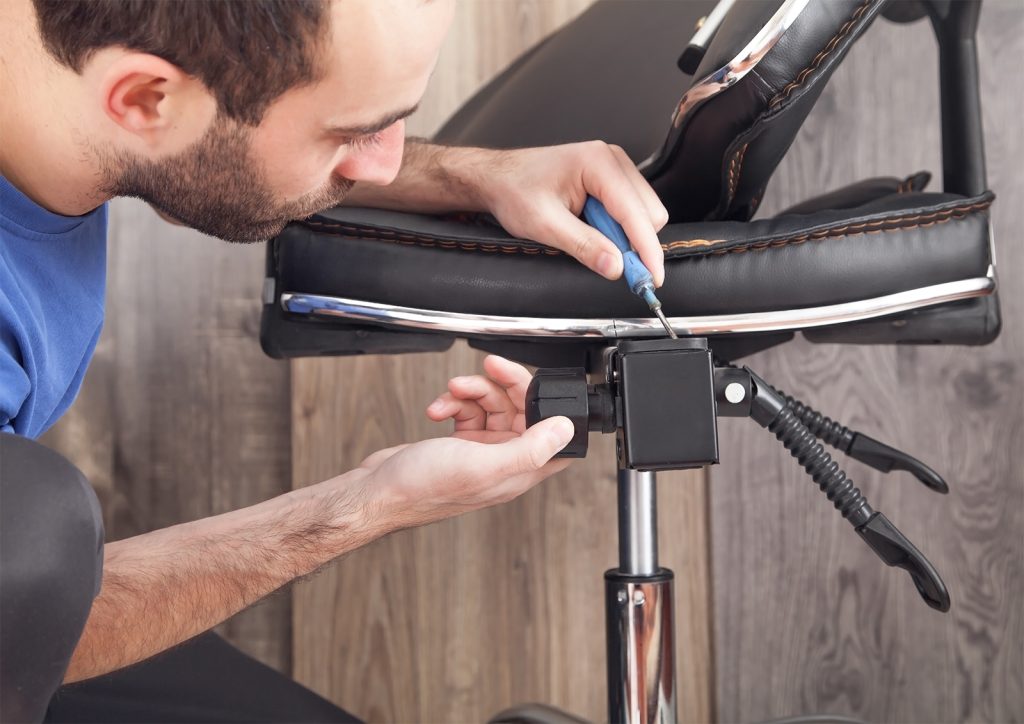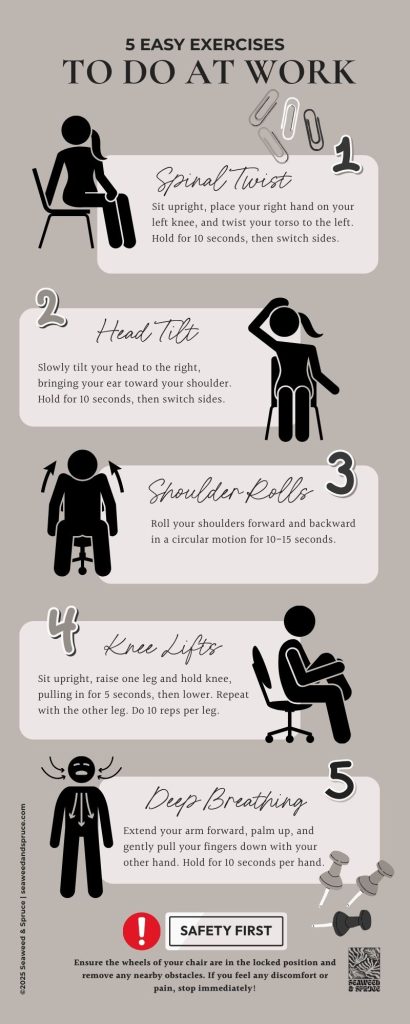Wellness in the Workplace

While updating a blog post on Boxwood & Bay, my lifestyle website, about the benefits of meditation, I was inspired to write this article on workplace wellness. Check out the full post on Boxwood & Bay’s blog here.
Wellness and the Digital Age
In today’s digital age, many of us spend a significant portion of our day sitting at a desk, staring at a screen and engaging in repetitive tasks. While office jobs may not seem physically demanding, prolonged sitting and poor posture can lead to long-term health issues such as back pain, neck strain and reduced circulation.
The good news is that by making small adjustments to your posture and incorporating simple exercises into your daily routine, you can improve your physical wellness, reduce discomfort and even boost productivity.
This blog post will provide a comprehensive guide on how to maintain good posture, take effective screen breaks and incorporate workplace-friendly exercises into your day for a healthier mind and body.

Why Good Posture Matters
The Impact of Poor Posture
Sitting for long hours in a slouched or incorrect position can lead to a variety of health concerns, including:
- Back and Neck Pain: Misalignment of the spine can strain muscles and ligaments.
- Poor Circulation: Sitting in one position for too long can reduce blood flow to the legs and feet.
- Headaches: Forward head posture can create tension in the neck, leading to headaches.
- Fatigue and Lack of Focus: Poor posture can restrict lung capacity, leading to reduced oxygen intake and lower energy levels.
- Increased Risk of Musculoskeletal Disorders: Chronic poor posture can contribute to long-term conditions such as carpal tunnel syndrome and sciatica.

10 Tips to Maintain Good Posture at Your Desk
1. Sit with Your Feet Flat on the Floor
Keep both feet planted on the ground to distribute weight evenly and reduce strain on your lower back. Avoid crossing your legs, as this can cause misalignment in your hips and spine.
2. Adjust Your Chair Height
Your chair should be at a height where your knees are at a 90-degree angle, level with or slightly below your hips. This position keeps your spine in a neutral alignment and reduces pressure on your lower back.
3. Support Your Lower Back
Use a chair with lumbar support or place a small cushion at your lower back to maintain its natural curve. This helps prevent slouching and reduces strain on the spine.
4. Keep Your Screen at Eye Level
Position your monitor so that the top of the screen is at or just below eye level. This prevents you from tilting your head forward, which can lead to neck and shoulder tension.
5. Maintain a Neutral Wrist Position
Keep your wrists straight and level with your elbows while typing. Using a wrist rest or an ergonomic keyboard can help prevent strain and conditions like carpal tunnel syndrome.
6. Sit with Your Back Straight
Engage your core muscles and avoid slouching forward. Keeping your shoulders relaxed and slightly pulled back helps maintain good posture.
7. Take Regular Screen Breaks (20-20-20 Rule)
Every 20 minutes, look at something 20 feet away for at least 20 seconds. This simple practice helps reduce eye strain and refreshes your focus.
8. Stretch and Move Every Hour
Standing up, stretching or taking a short walk every hour prevents stiffness and improves circulation. Try setting a reminder to take movement breaks.
9. Use a Headset for Calls
Avoid cradling your phone between your shoulder and ear. Using a headset reduces neck strain and promotes better posture.
10. Position Your Keyboard and Mouse Correctly
Keep your keyboard and mouse close enough to prevent overextending your arms. Your elbows should be at a 90-degree angle to reduce shoulder and wrist strain.
Wellness in the Office: 10 Easy Exercises to Do at Work for a Healthy Mind and Body
1. seated spinal twist
Sit upright, place your right hand on your left knee and twist your torso to the left. Hold for 10 seconds, then switch sides. This stretch helps improve spinal flexibility and relieves tension.
2. neck stretch
Slowly tilt your head to one side, bringing your ear toward your shoulder. Hold for 10 seconds, then switch sides. This stretch reduces neck strain from screen time.
3. Shoulder rolls
Roll your shoulders forward and backward in a circular motion for 10-15 seconds. This relieves upper body tension and improves posture.
4. knee lifts
Sit upright with both feet on the floor. Lift one knee toward your chest and hold for 5 seconds, then lower. Repeat with the other leg. Do 10 reps per leg to engage core muscles and improve circulation.
5. desk push-ups
Place hands on your desk, step back and lower yourself toward the desk before pushing back up. Do 10 reps to strengthen arms, chest and shoulders.
6. seated or standing calf raises
Lift your heels off the ground and hold for 5 seconds, then lower. Repeat 15 times to improve circulation and strengthen calves.
7. wrist and finger stretch
Extend your arm forward, palm up and gently pull your fingers down with your other hand. Hold for 10 seconds per hand to reduce wrist strain from typing.
8. deep breathing exercises (box breathing)
Inhale for 4 seconds, hold for 4 seconds, exhale for 4 seconds, hold for 4 seconds. Repeat for one minute to lower stress and increase focus.
9. seated forward roll
While sitting, slowly bend forward and reach for your toes. Hold for 10-15 seconds to stretch the lower back and hamstrings.
10. eye relaxation exercise (palming)
Rub your hands together to generate warmth, then cup them over your closed eyes for 20 seconds. This reduces eye strain and refreshes vision.

Wellness in the Workplace: Downloadable Infographic
Maintaining good posture and incorporating movement into your workday can significantly improve your health, productivity and overall wellness. By following these simple tips and exercises, you can prevent common workplace ailments and keep your body feeling energised and comfortable.
To help you get started, we’ve created a free downloadable infographic summarising five easy, essential posture tips and exercises for office wellness. Keep it at your desk as a quick reference to remind yourself to stay active and maintain good posture throughout the day.
Start implementing these habits today and you’ll soon notice a difference in how you feel at the end of each workday. Small changes can lead to long-term benefits, ensuring a healthier and happier you!
What steps will you take today to improve your posture and wellness at work? Let us know in the comments below… In the meantime, download our ‘5 Easy Exercises to Do at Work’ infographic.

